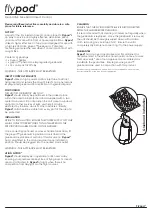
WCB11070 (PDF FORMAT)
22
©
Copyright Eaton Corp. 2007, All Rights reserved.
Figure 19
4.7.12 Carefully place the piston onto the cylinder with the
chamfered edge of the piston facing downward, taking
special care to avoid damaging the seal lips.
4.7.13 Gradually apply an evenly distributed force to press
the piston into the cylinder being sure not to cock the
piston which may damage the sealing surfaces. The
use of 'C-clamps' may assist with the assembly pro-
cess.
4.7.14 Using a lifting strap, slide the cylinder/piston assembly
onto the studs.
4.7.15 Lubricate the threads on the end of the studs with 30
wt. oil or anti-seizing compound and install the wash-
ers (17) and locknuts (18) .
4.7.16 While supporting the weight of the cylinder/piston
assembly, tighten the locknuts, ONE TURN AT A
TIME and in an alternating (crosswise) pattern until
the cylinder is seated firmly against the clamp tubes.
Torque the locknuts to the appropriate value. See
Table 4.
The locknuts (18) must be tightened gradually
to prevent damage to the tensioner compo-
nents.
4.7.17 Connect an air supply line to one of the ports in the
cylinder, plugging the remaining port(s).
4.7.18 Perform an air test by applying 80 PSIG (5.5 bar) to
engage the tensioner. Shut off the air supply. If the air
pressure does not drop below 70 PSIG (4.8 bar) after
10 minutes, the seals have been properly installed. If
excessive leaking is found, disassemble the piston /
cylinder and inspect the seals or sealing surfaces for
damage. repair or replace components as required.
4.8
Bushing Replacement
Note :
Some pressure plate and reaction plates have
bushings installed in the reaction holes. (Typically cor-
rosion resistant units, and older size 36" tensioners).
See
Figure 20
. If applicable, replacement of the bush-
ings can be performed per the following procedures.
Figure 20
4.8.1
Disassemble per Section 4.3.
4.8.2
Refer to the wear limits in Table 13 to determine if the
bushings (54) require replacement.
4.8.3
Heat up the area around each bushing to soften the
Loctite
®
and press out the old bushings.
4.8.4
Clean the bores in the mating component, removing
any residual Loctite
®
.
4.8.5
Apply Loctite
®
#RC601, 635 or 680 to the bushing
O.D. and mating hole in the reaction plate using a
swab. Apply enough liquid to entirely fill the space
between the parts. Install the bushings by twisting the
bushing while pushing it down, until it is flush with the
casting surface. Inspect to see that a ring of liquid
adhesive is visible at the parting line. Reapply Loctite
if required. Allow the Loctite to cure for 15 minutes
before moving the sub assembly.
4.8.6
Assemble the tensioner per section 4.9, as required.
8 & 14
WCB2
18, 24, 36 &
48 WCB2
















































